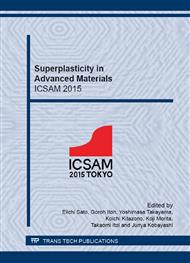[1]
T.G. Langdon, The mechanical properties of superplastic materials, Metall. Trans. A 13A (1982) 689-701.
Google Scholar
[2]
R.Z. Valiev, R.K. Islamgaliev, I.V. Alexandrov, Bulk nanostructured materials from severe plastic deformation, Prog. Mater. Sci. 45 (2000) 103-189.
DOI: 10.1016/s0079-6425(99)00007-9
Google Scholar
[3]
R.Z. Valiev, T.G. Langdon, Principles of equal-channel angular pressing as a processing tool for grain refinement, Prog. Mater. Sci. 51 (2006) 881-981.
DOI: 10.1016/j.pmatsci.2006.02.003
Google Scholar
[4]
A. P. Zhilyaev, T. G. Langdon, Using high-pressure torsion for metal processing: Fundamentals and applications, Prog. Mater. Sci. 53 (2008) 893-979.
DOI: 10.1016/j.pmatsci.2008.03.002
Google Scholar
[5]
T.G. Langdon, A unified approach to grain boundary sliding in creep and superplasticity, Acta. Metall. Mater. 42 (1994) 2437-2443.
DOI: 10.1016/0956-7151(94)90322-0
Google Scholar
[6]
R.Z. Valiev, D.A. Salimonenko, N.K. Tsenev, P.B. Berbon, T.G. Langdon, Observations of high strain rate superplasticity in commercial aluminum alloys with ultrafine grain sizes, Scripta Mater. 37 (1997) 1945-(1950).
DOI: 10.1016/s1359-6462(97)00387-4
Google Scholar
[7]
T.G. Langdon, Seventy-five years of superplasticity: historic developments and new opportunities, J. Mater. Sci. 44 (2009) 5998-6010.
DOI: 10.1007/s10853-009-3780-5
Google Scholar
[8]
K. Higashi, M. Mabuchi, T.G. Langdon, High-strain-rate superplasticity in metallic materials and the potential for ceramic materials, ISIJ Intl. 36 (1996) 1423-1438.
DOI: 10.2355/isijinternational.36.1423
Google Scholar
[9]
R.Z. Valiev, O.A. Kaibyshev, R.I. Kuznetsov, R. Sh. Musalimov, N.K. Tsenev, Low-temperature superplasticity of metallic materials, Dokl. Akad. Nauk. SSSR (Proc. USSR Acad. Sci. ) 301 (1988) 864–866.
Google Scholar
[10]
M. Kawasaki, T. G. Langdon. Principles of superplasticity in ultrafine-grained materials, J. Mater. Sci. 42 (2007) 1782-1796.
DOI: 10.1007/s10853-006-0954-2
Google Scholar
[11]
M. Kawasaki, T. G. Langdon. Review: achieving superplasticity in metals processed by high-pressure torsion, J. Mater. Sci. 49 (2014) 6487-6496.
DOI: 10.1007/s10853-014-8204-5
Google Scholar
[12]
M. Kawasaki, N. Balasubramanian, T. G. Langdon. Flow mechanisms in ultrafine-grained metals with an emphasis on superplasticity, Mater. Sci. Eng. A 528 (2010) 6624-6629.
DOI: 10.1016/j.msea.2011.05.005
Google Scholar
[13]
M.E. Kassner, M. -T. Pérez-Prado, Five-power-law creep in single phase metals and alloys, Prog. Mater. Sci. 45 (2000) 1-102.
DOI: 10.1016/s0079-6425(99)00011-0
Google Scholar
[14]
M.F. Ashby, A first report on deformation-mechanism maps. Acta Metall. 20 (1972) 887-897.
DOI: 10.1016/0001-6160(72)90082-x
Google Scholar
[15]
F.A. Mohamed, T.G. Langdon, Deformation mechanism maps based on grain size, Metall. Trans. 5 (1974) 2339-2345.
DOI: 10.1007/bf02644014
Google Scholar
[16]
T.G. Langdon, F.A. Mohamed, A new type of deformation mechanism map for high temperature creep, Mater. Sci. Eng. 32 (1978) 103-112.
DOI: 10.1016/0025-5416(78)90029-0
Google Scholar
[17]
T.G. Langdon, F.A. Mohamed, A simple method of constructing an Ashby-type deformation mechanism map, J. Mater. Sci. 13 (1978) 1282-1290.
DOI: 10.1007/bf00544735
Google Scholar
[18]
M. Kawasaki, T.G. Langdon, The many facets of deformation mechanism mapping and the application to nanostructured materials, J. Mater. Res. 28 (2013) 1827-1834.
DOI: 10.1557/jmr.2013.55
Google Scholar
[19]
M. Kawasaki, T.G. Langdon, Characteristics of high temperature creep in pure aluminum processed by equal-channel angular pressing, Mater. Sci. Forum 638-642 (2010) 1965-(1970).
DOI: 10.4028/www.scientific.net/msf.638-642.1965
Google Scholar
[20]
M. Kawasaki, I.J. Beyerlein, S.C. Vogel, T.G. Langdon, Characterization of creep properties and creep textures in pure aluminum processed by equal-channel angular pressing, Acta Mater. 56 (2008) 2307-2317.
DOI: 10.1016/j.actamat.2008.01.023
Google Scholar
[21]
M. Kawasaki, T.G. Langdon, Grain boundary sliding in a superplastic zinc-aluminum alloy processed using severe plastic deformation, Mater. Trans. 49 (2008) 84-89.
DOI: 10.2320/matertrans.me200720
Google Scholar
[22]
M. Kawasaki, T.G. Langdon, Developing superplasticity and a deformation mechanism map for the Zn–Al eutectoid alloy processed by high-pressure torsion, Mater. Sci. Eng. A 528 (2011) 6140-6145.
DOI: 10.1016/j.msea.2011.04.053
Google Scholar
[23]
Y.H. Zhao, Y.Z. Guo, Q. Wei, A.M. Dangelewicz, C. Xu, Y.T. Zhu, T.G. Langdon, Y.Z. Zhou, E. Lavernia, Influence of specimen dimensions on the tensile behavior of ultrafine-grained Cu. Scripta Mater. 59 (2008) 627-630.
DOI: 10.1016/j.scriptamat.2008.05.031
Google Scholar
[24]
H. Ishikawa, F.A. Mohamed, T.G. Langdon, The influence of strain rate on ductility in the superplastic Zn-22% Al eutectoid, Phil. Mag. 32 (1975) 1269-1271.
DOI: 10.1080/14786437508228105
Google Scholar
[25]
M. Kawasaki, S. Lee, T.G. Langdon, Constructing a deformation mechanism map for a superplastic Pb–Sn alloy processed by equal-channel angular pressing, Scripta Mater. 61 (2009) 963-966.
DOI: 10.1016/j.scriptamat.2009.08.001
Google Scholar
[26]
M. Kawasaki, A.A. Mendes, V.L. Sordi, M. Ferrante, T.G. Langdon, Achieving superplastic properties in a Pb-Sn eutectic alloy processed by equal-channel angular pressing, J. Mater. Sci. 46 (2011) 155-160.
DOI: 10.1007/s10853-010-4889-2
Google Scholar
[27]
M. Kawasaki, J. Foissey, T.G. Langdon, Development of hardness homogeneity and superplastic behavior in an aluminum–copper eutectic alloy processed by high-pressure torsion, Mater. Sci. Eng. A 561 (2013) 118-125.
DOI: 10.1016/j.msea.2012.10.096
Google Scholar
[28]
A.H. Chokshi, T.G. Langdon, The mechanical properties of the superplastic Al- 33 Pct Cu eutectic alloy, Metall. Trans. A 19A (1988) 2487-2496.
DOI: 10.1007/bf02645476
Google Scholar
[29]
S.V. Divinski, G. Reglitz, H. Rösner, Y. Estrin, G. Wilde, Ultra-fast diffusion channels in pure Ni severely deformed by equal-channel angular pressing, Acta Mater. 59 (2011) 1974-(1985).
DOI: 10.1016/j.actamat.2010.11.063
Google Scholar
[30]
B. Ahn, A.P. Zhilyaev, H. -J. Lee, M. Kawasaki, T.G. Langdon, Rapid synthesis of an extra hard metal matrix nanocomposite at ambient temperature, Mater. Sci. Eng. A 635 (2015) 109-117.
DOI: 10.1016/j.msea.2015.03.042
Google Scholar


